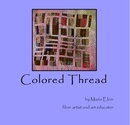Only one more Daily Notes strip is needed to complete my year of stitching. I need to lay them all out and see what 2016 looked like. Each week I also sewed the scraps together into a larger quilt-top- very randomly. I've done some nui-shibori on it and overdyed it in indigo, and the piece is already being stitched up with imagery related tot he brain and perception. I'm hoping to finish and display it with the Skirkanich work I did over the summer at the exhibit we'll have at Westttown School in March.

That leaves me wondering about next year. I really enjoyed having an "assignment" for myself to work on each week. Although by the time August came it started dragging, I rallied through the Fall to finish strong. It's strange how over the summer, when I have all the time in the world I work less than during the school year when I'm busy beyond measure.
I've been debating about a project for 2017. I don't want to continue the daily note strips. I want to start something different. The weekly format fit well with my schedule, but the size of the weekly piece must remain small enough to complete in a week.
I liked the photo collages I made last spring, but the collaborative aspect collapsed. I think I could keep up with a photo a day or at least a few a week. These are 2 versions of a photo collage layering up, filtering, and thresholding images I took this past week during a trip to Quebec. The threshold effect loses some of the imagery, abstracting it a bit. I could print the images on fabric and then stitch over them. I could screenprint them...
I saw an interesting exhibit at the Musee National des Beaux Arts du Quebec by Diane Morin. Rows of model trees were set up in front of strips of LED lights which projected the shadows of the trees onto a large screen. As the light program strobed sequences of light combinations across the rows, the shadows flickered and shifted, like watching stop motion videos of plants growing or like watching trees fly by your car window on a foggy day. It was entrancing.. she called it "Machines a Reduire le Temps" or Machines for compressing time.
Also at the MNBAQ I saw a retrospective of Pierre Bonnard, whose color sense I have always loved. There were several snapshots in a case, some of which were everyday scenes of people in his life, and others looked like visual sketches working out painting compositions. There were several self-portraits I'd never seen before. He seems to always put his face in shadows so you can't really see his eyes.
Maybe I should do some more self-portraits. It's a way of freezing time. We change so much as we get older. My inside vision of myself and my outward appearance don't really match anymore. My daily notes project started with thinking about each day as a pixel of the bigger picture of life. The final view of all the strips should reveal how my year really was. Perception as a concept is something I'd like to keep exploring...
Another idea I had was to do something called "The Sky is Falling". All the news every day seems to cause a doomsday feeling. I'm worried all the time. If so many terrible things can happen everywhere all the time, what is there to stop it from happening here? But maybe it's just the media playing Chicken Little with me. Art is cathartic. So a thought I had was to screen a picture like this of the sky and stitch my worries or concerns each week- images? words? fragments? a piece of sky falling. Maybe I could print it large and cut off fragments...
I don't know yet...
I will finish my last daily notes strip tomorrow.
I'll take photos this next week.
I'll think some more.




























